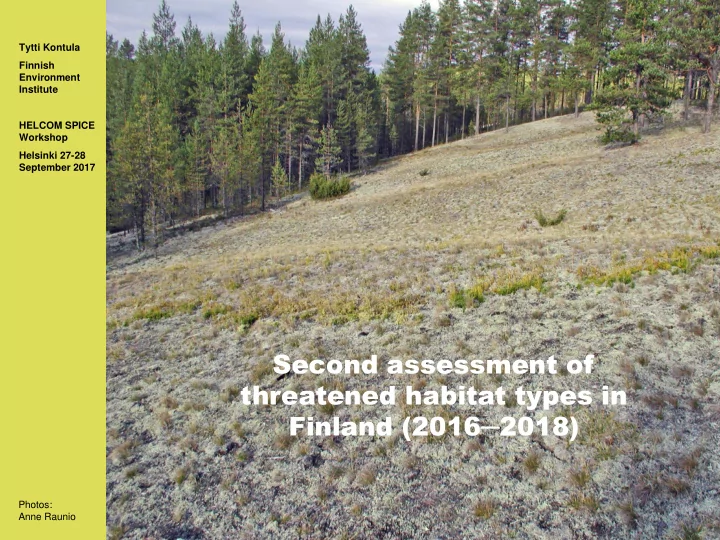

Tytti Kontula Finnish Environment Institute HELCOM SPICE Workshop Helsinki 27-28 September 2017 Second assessment of threatened habitat types in Finland (2016─2018) Photos: Anne Raunio
First Finnish Red List of habitats was prepared in 2008: • Baltic Sea (12 underwater habitats) • Coastal habitats (41) • Inland waters and shores (43) • Mires (70) • Forests (73) • Rocky habitats (43) • Seminatural grasslands & grazed woodlands (40) • Fell habitats (46)
Finnish RLE 2008 Zostera meadows: Endangered (EN) Photo: Hannele Kekäläinen In all, 368 habitat types were assessed and 51 % of them were categorized threatened. Photo: Parks & Wildlife Finland Photo: Tiina Tonteri Photo: Rauno Benthic habitats dominated by Ruuhijärvi Mytilus spp. : Near Threatened (NT) Photo: Parks & Wildlife Finland
Second Red List of habitats in 2018 In 2008 assessment only 12 habitats Now divided in 47 habitat types 1.1 Benthic habitats characterized by epibenthic macroscopic organisms (at least 10% coverage) Benthic habitats characterized by perennial algae New classification based on 1.1.1 1.1.1.1 Benthic habitats dominated by Fucus spp. HELCOM HUB 1.1.1.2 Benthic habitats dominated by corticated red algae (with the exception of substrate 1.1.1.3 Benthic habitats dominated by perennial filamentous algae being combined for the fifth / sixth 1.1.2 Benthic habitats dominated by aquatic moss level biotopes) Benthic habitats characterized by emergent vegetation 1.1.3 1.1.3.1 Reedbeds / Benthic habitats dominated by common reed (Phragmites australis) 1.1.3.2 Benthic habitats dominated by Cyperaceae 1.1.3.3 Benthic habitats dominated by Typha spp. 1.1.3.4 Benthic habitats dominated by Equisetum fluviatile 1.1.3.5 Benthic habitats dominated by Hippuris spp. Benthic habitats characterized by submerged vegetation 1.1.4 1.1.4.1 Benthic habitats dominated by Potamogeton spp. and/or Stuckenia pectinata 1.1.4.2 Benthic habitats dominated by Ranunculus spp. 1.1.4.3 Benthic habitats dominated by Zannichellia spp. and/or Ruppia spp. 1.1.4.4 Benthic habitats dominated by watermilfoil (Myriophyllum spicatum and/or Myriophyllum sibiricum)
Second Red List of habitats in 2018 Some entirely new parts in the assessment: pelagic habitats & seasonal ice Preliminary division of pelagic habitats in Finland: Baltic Proper & Gulf of Finland Bothnian Sea & Åland Sea Bothnian Bay Assessment combines physical-chemical variables with data on plankton, fish & top predators.
Background data in the assessments All key organizations involved and their data utilized • Based on VELMU data (underwater inventory program) and related modelling current situation • Reference states (1960s or earlier) inferred from various data indirectly
New IUCN Red List of Ecosystems Criteria In the second assessment Finland is using the new IUCN Red List of Ecosystems criteria
New IUCN Red List of Ecosystems Categories
Three of the RLE criteria based on comparisons: how quantity or quality has changed or will change RLE assessment results can’t be directly interpreted e.g. in terms of GES From IUCN (2016): GUIDELINES FOR THE APPLICATION OF IUCN RED LIST OF ECOSYSTEMS CATEGORIES AND CRITERIA
Example: Benthic habitats dominated by Fucus spp. Criterion A: quantitative changes Distribution models using current environmental data and estimates of Secchi-depth values from 100 years ago Fucus decline of c. 60% in 100y From the presentation of Lasse Kurvinen (Parks & Wildlife Finland)
Progress in the second assessment Assessments completed by the end of this year • Progress slower than expected and large variation among main habitat type groups • Baltic Sea team rather well in overall project schedule • Baltic Sea team has taken on an extra task of producing descriptions in English • All 47 habitat type descriptions will be prepared both in English and Finnish • Basic assessment documentation preferrably both in English and Finnish • Results or their summary also in English
Thank you !
Example: Benthic habitats dominated by Fucus spp. Criterion D: biotic degradation Indicator developed for the Water Framework Directive monitoring: maximum depth of Fucus zone (below shown for a subregion using ecological quality ratios (EQR)) Observations Reference value 1998 - 2014 Ecological Quality Ratio Collapse value From Ruuskanen (2014))
Example: Benthic habitats dominated by Fucus spp. Criterion D: biotic degradation Indicator developed for the Water Framework Directive monitoring: maximum depth of Fucus zone (below shown for a subregion using ecological quality ratios (EQR)) Observations Reference value 1998 - 2014 Ecological Quality Ratio a b Collapse value From Ruuskanen (2014))
Example: Benthic habitats dominated by Fucus spp. Criterion D: biotic degradation Combining subregion estimates indicated a change with 48% relative severity for this biotic indicator vulnerable VU. However, experts agreed that the indicator used is NOT SENSITIVE enough to capture all degradation. Fucus zones get thinner even before the maximum depth of the zone changes. Expert team believed that the relative severity would exceed 50%, if there were a way to really measure all degradation. endangered EN was assigned as the final threat category
Simpler example: Benthic habitats dominated by Ranunculus spp. Criterion A: estimate on decline generated purely by expert opinion based on knowledge of main pressures declined 20 – 30 % in last 50 years near threatened NT Criterion B : widespread and abundant least concern LC Criterion C: data deficient DD Criterion D: data deficient DD
Recommend
More recommend